Defining the common terms you'll see in the Word Cracking Resources
In this article, we glossarise the common morphological terms you will see in the Word Cracker manual, other blog posts and videos and on the Online Word Cracker. Before we dive in, we had better explain (for newbie word nerds) why we bother teaching morphology in the first place!
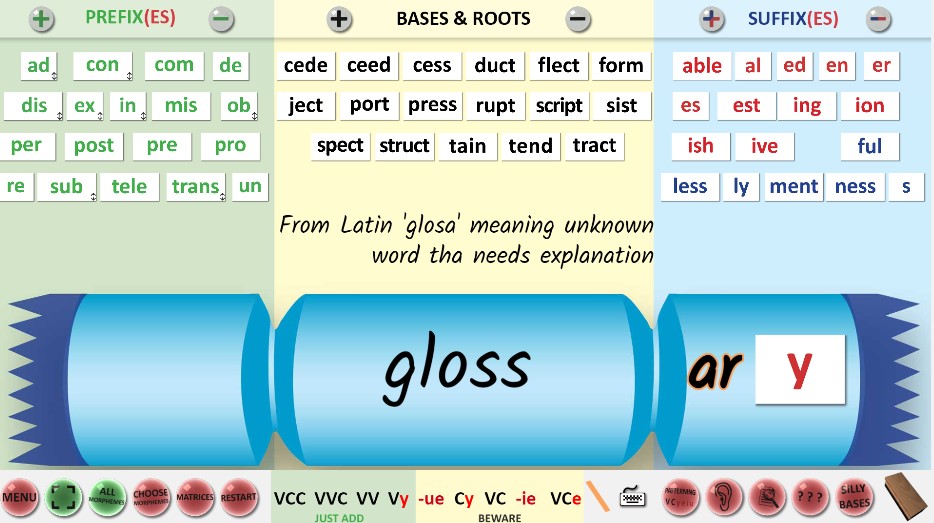
Why teach morphology?
From the earliest days in school, we teach students the alphabetic code and they will practise their spelling with single syllable words as they build up their phonemic knowledge. In the main this goes along well until we reach tricky heart words such as ‘says,’ ‘goes,’ and ‘does’ which cannot be segmented according to the phonemes that are heard. Students will often struggle with words like these well into primary school unless they are taught the reason behind such spellings and here begins the self-talk ‘I’m a hopeless speller!’ [ More on says ,goes, does later].
Gradually students move to multi syllable words but at this point the spelling may become shaky and unreliable. When you consider the level of skill required for accurate spelling it is hardly surprising. The student will need be able to break words into syllables and then by using their existing knowledge of the alphabetic code segment each syllable according to the sounds that they can hear. The student will also need to have a good understanding of short and long vowel sounds and a degree of proficiency around consonant blends which are troublesome to so many struggling learners. Then of course there is the added difficulty of when to employ spelling rules such as the Double rule or the Drop e rule or Change y to i rule.
The terminology
Affix
A morpheme that is attached to a word to change its meaning or grammatical function, such as prefixes and suffixes. In the word ‘reporter’ the base ‘port’ is affixed with the prefix ‘re’ (meaning back) and the suffix ‘er’ (meaning someone who). These affixes fix to the base ‘port’ (meaning to carry) and alter its meaning to someone who carries back information.
Accent (stress) on a syllable
In words with more than one syllable, not all syllables will be spoken equally. Some syllables are said for a little longer than others. In the word compel, the second syllable (pel) runs for a little longer than the first (com). The pel syllable takes a fraction of a second longer to say, and because of this, we call it the stressed (or accented) syllable. Knowing which syllable is stressed matters when we teach the doubling rule part 2.
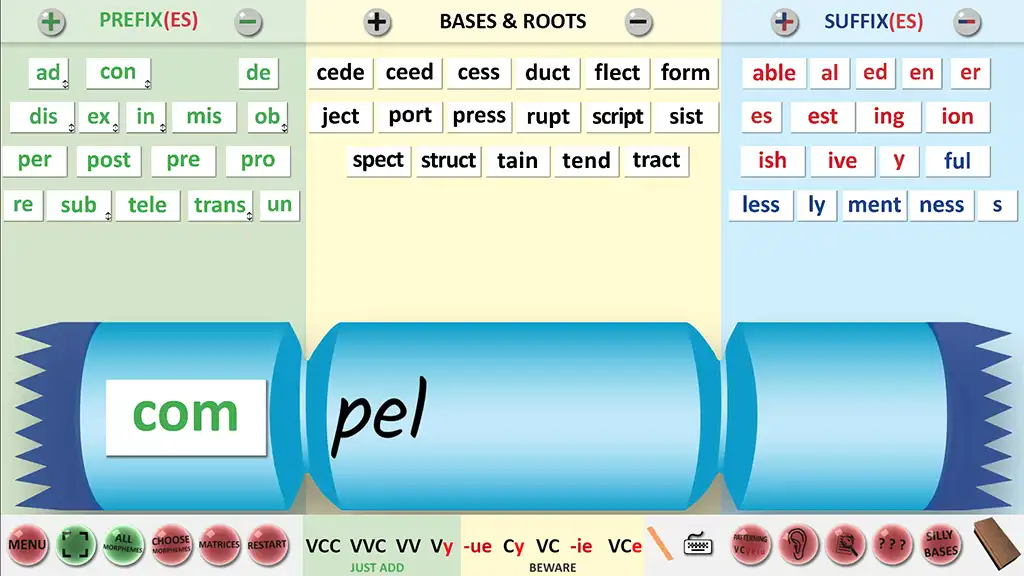
Add 'k' rule
A suffixing spelling rule that dictates that when a vowel suffix (e.g. -ing, -y or -er), is being added to a base word ending in the letters ‘-ic’, a ‘k’ must be added to the end of the base before adding the vowel suffix. The letter ‘k’ creates a boundary between the ‘c’ and the first letter of the suffix and keeps the letter ‘c’ making a hard sound. Without the ‘k’, the letter ‘c’ on the end of panic would have to say it’s soft (s) sound. See image

All Morpheme Mode
(Online Word Cracker)

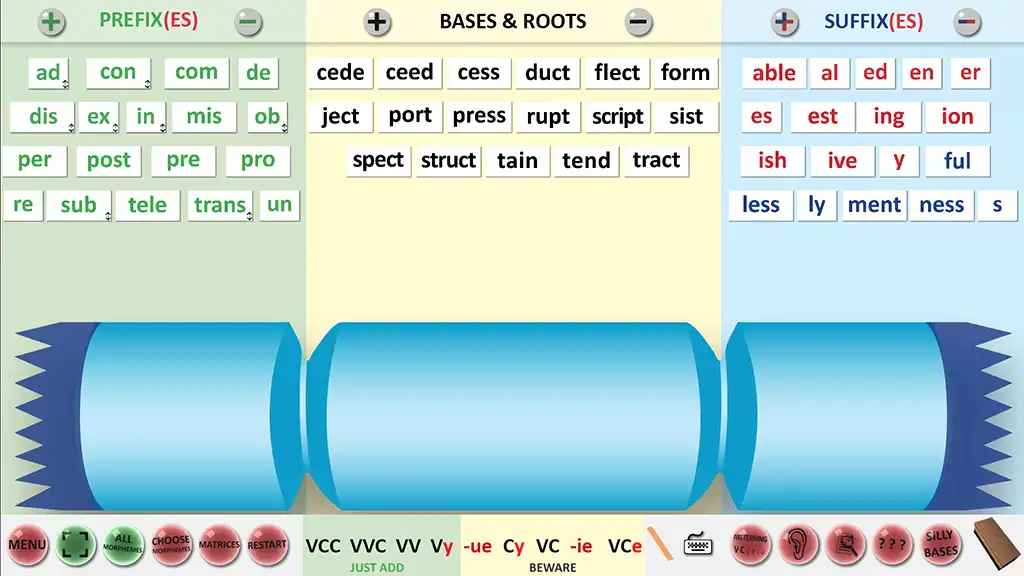
Add, Double, Drop, Change
When suffixes are being added to bases or roots there are often spelling changes that need to be made to the bases or roots. These changes fall into a group of spelling rules called The Big 3 spelling rules. In Word Cracking, we call these the Add, Double, Drop, Change rules. These rules all need to be taught to students gradually and in step with the words they are coming across in the structured synthetic phonics program that is being used.
Add:
Double:
Drop:
Change:
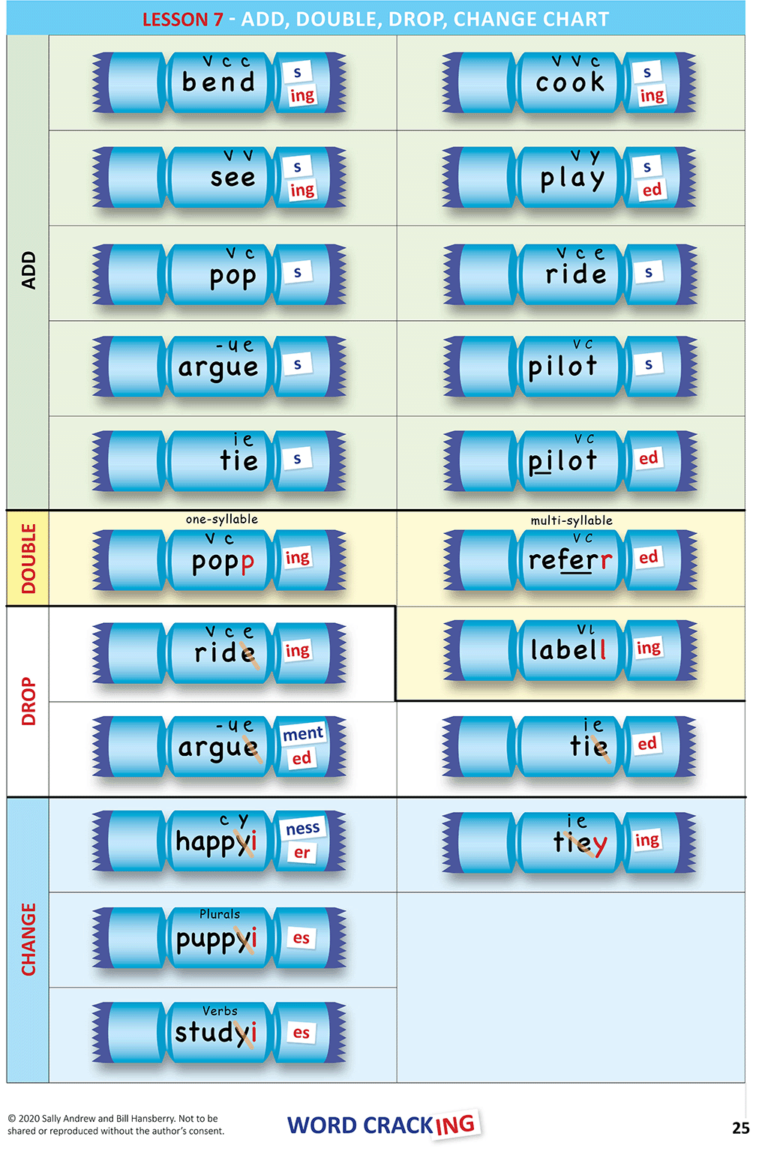
Base / Root
Base (word)
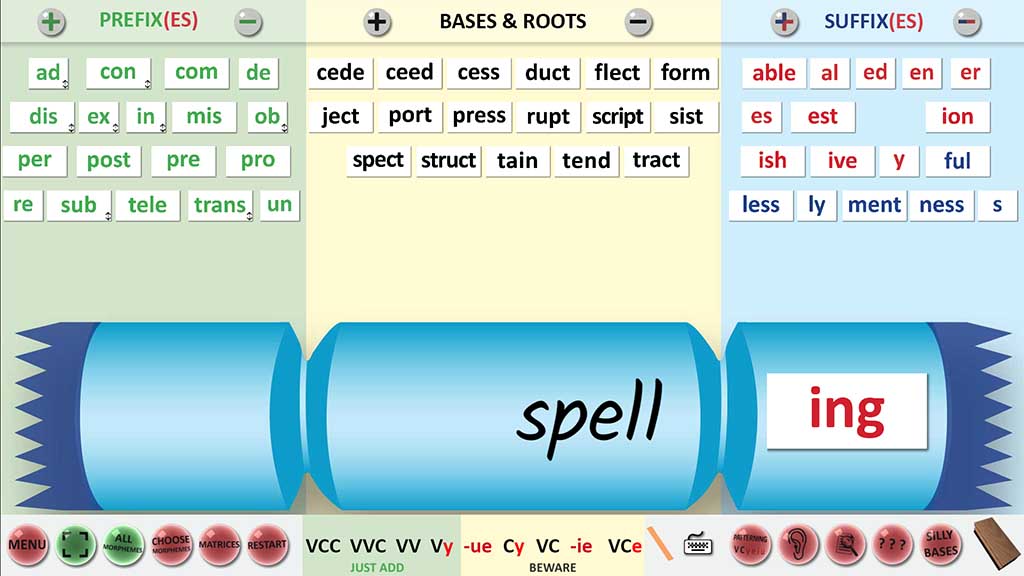
Root
Also known as a bound morpheme, typically can’t stand alone. It must have a prefix or suffix added to be a compete word. The example Word Cracker (on the right) is made up of the root flect meaning to bend or curve, and cannot stand alone as a word in a sentence: The light will flect. Adding prefix re makes reflect, which is now a complete word that can stand alone: The light will reflect.
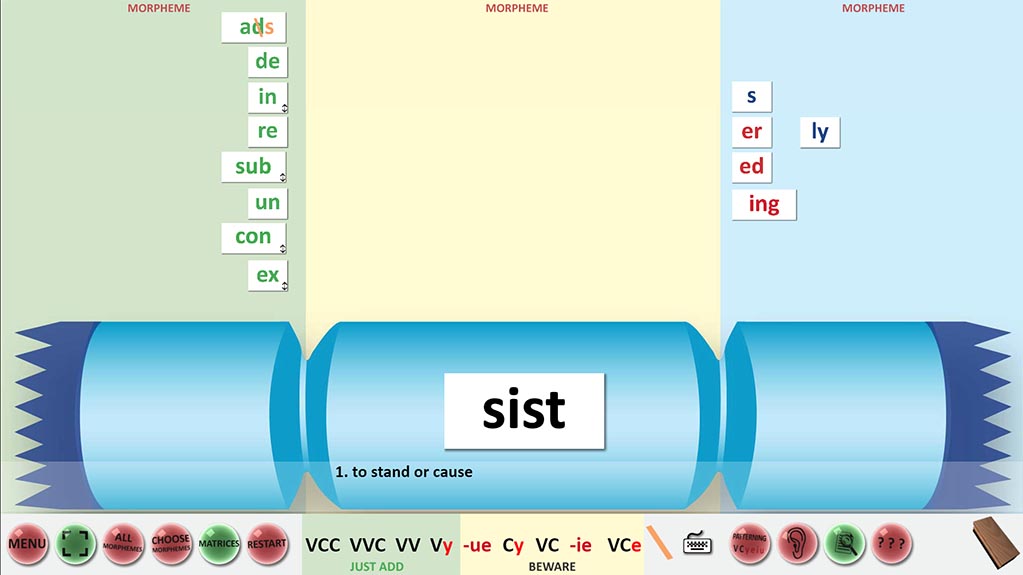
Bound morpheme (root)
Also known as a root, typically can’t stand alone. It must have a prefix or suffix added to be a compete word. The example Word Cracker (on the right) is made up of the root flect meaning to bend or curve, and cannot stand alone as a word in a sentence: The light will flect. Adding prefix re makes reflect, which is now a complete word that can stand alone: The light will reflect. root

Chameleon prefix
Also known as an assimilated prefix, a chameleon prefix changes its form depending on the initial sound of the base it attaches to. An example is when the prefix “in-” (which can take the forms “il-“, “im-“, “ir-“, or “un-“) is changed to il- and fixed onto legal to make illegal.
In the Word Cracker on the right, the word ‘suffix‘ takes the prefix ‘suf‘ that is a chameleon of ‘sub‘, making it much easier to pronounce.
Choose Morpheme Mode
(Online Word Cracker)

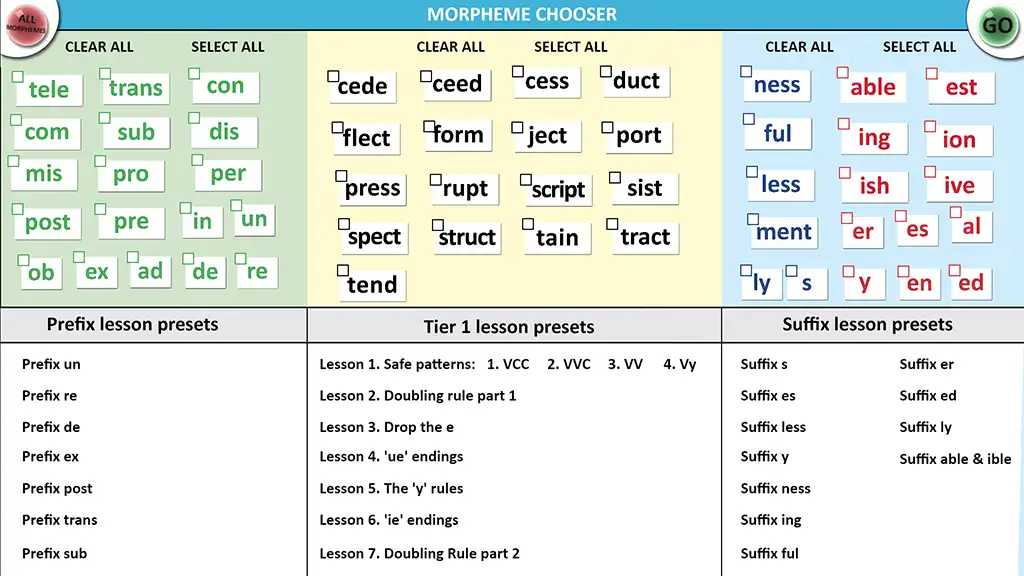
The Change Rule
Spelling Rule
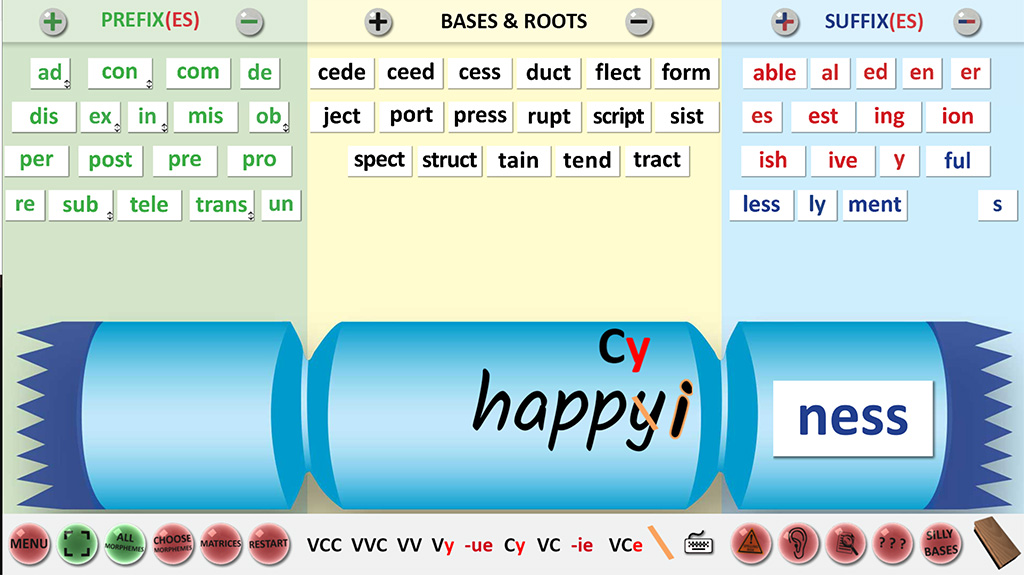
Cracker Cup
A suite of games in the Word Cracking Manual (and the Word Cracking website) for small groups or whole classes that consolidates morphological concepts and vocabulary building. There is also a suite of video based lessons called Cracker Cup Challenges that teachers can use with groups along with a blog post that explains how run these challenges in a step-by-step way.
Compound Word
A word formed by combining two or more words (bases), such as “doghouse” or “hamburger”.

Derivational Morpheme
An affix that changes the meaning or grammatical category of a word, such as the “-ness” in “happiness”. Derivational morphemes create/derive a new word, which gets its own entry in the dictionary. Derivational morphemes help us to create new words out of base words.
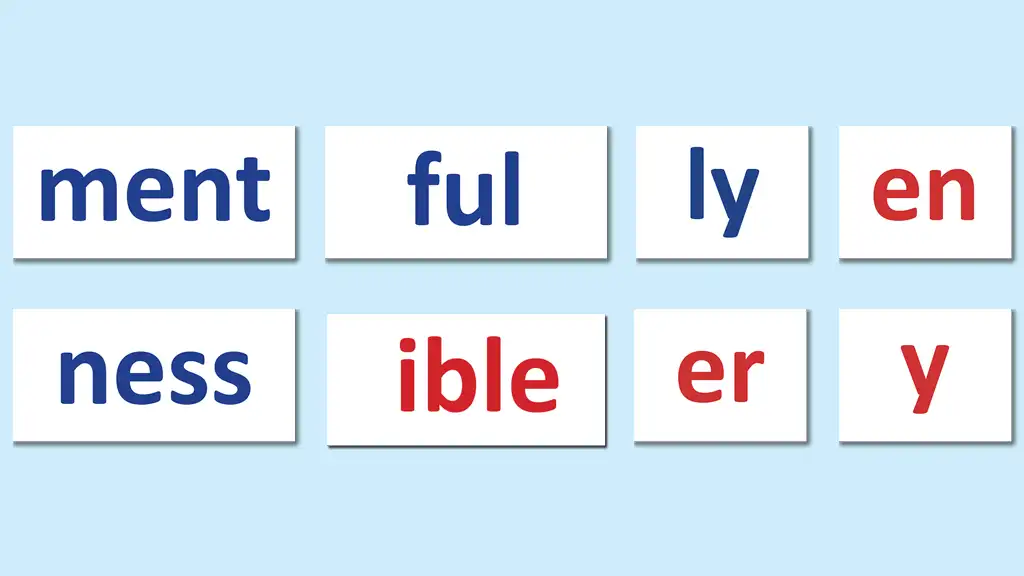
Doubling Rule Part 1
Spelling Rule
One of the Add, Double, Drop, Change spelling rule family. Also known as the 111 doubling rule.
If a one syllable word has ONE VOWEL, followed by ONE consonant (VC end pattern), and we are adding a VOWEL SUFFIX, then the final consonant must be DOUBLED to keep the syllable closed and the vowel sound short in the base or root: bat + ing = batting.
If we are adding a CONSONANT SUFFIX we just add the suffix because we don’t need to keep the vowel sound short: bit + s = bits. Of course, there are some exceptions to this rule.

Doubling Rule Part 2
Spelling Rule
One of the Add, Double, Drop, Change spelling rule family. Also known as the 211 doubling rule.
When the final syllable of a multi-syllable word is stressed (see definition for ‘Accent’), we must double the final consonant when adding a vowel suffix to the base word. Begin+ ing becomes beginning because the stress is on the final syllable: gin.
When the final syllable is unstressed and the stress is on a syllable before it, then the final consonant does NOT have to be doubled: focus + ed becomes focused because the stress is on the first syllable: fo.
Of course, there are some exceptions to this rule.
Drop 'e' Rule
Spelling Rule
One of the Add, Double, Drop, Change spelling rule family. Also known as the silent ‘e’ rule.
When a base or root ends in a vowel-consonant-e (magic ‘e’) end pattern (VCe) the final ‘e’ must nearly always be dropped before a vowel suffix can be added.
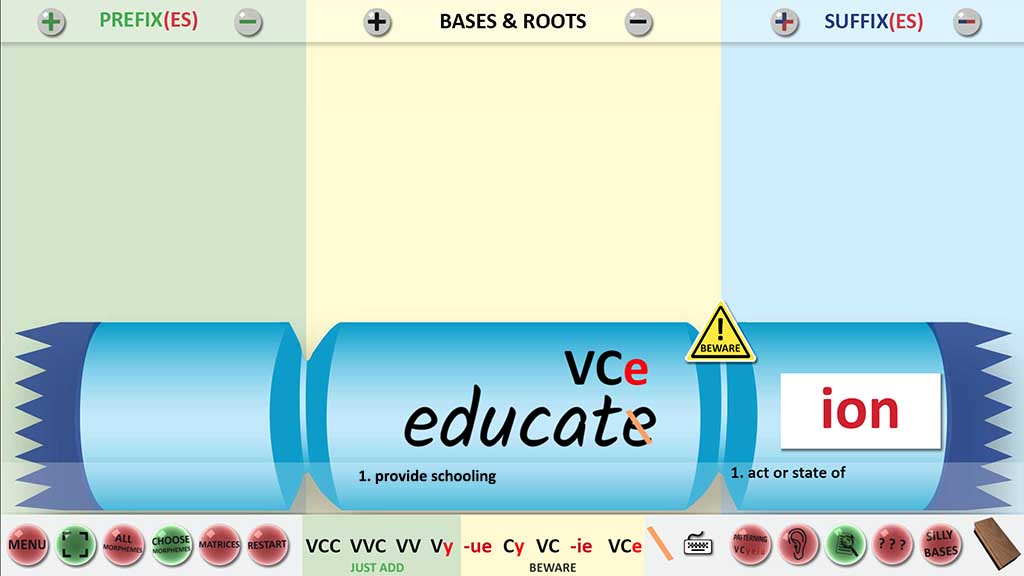
Free Morpheme

Grammar
Abstract Noun
A noun that you can’t see or touch. Abstract nouns name feelings or ideas. Some bases are tured into abstract nouns by the addition of suffix ‘ness’, e.g. sad + ness = sadness. The base ‘sad’ was changed from an adjective to an abstract noun when siffix ‘ness’ was added.
Adjective
An adjective describes a noun. Adjectives can be formed by the addition of a number of suffixes (see Grammar chart).
Adverb
An adverb describes a verb. describes a
verb. Adverbs tell us how, when, how often
or where something is done. The suffix ‘ly’, when added to bases or roots, can form an adverb.
In the sentence The dog ran quickly, ‘quickly’ is the adverb telling us how the dog ran. It is important to mention that not all adverbs end in suffix ‘ly’.

Inflectional Morpheme
An affix that changes the grammatical function of a word, such as the “-s” in “bat” to indicate plurality (more than one bat).

Matrices Mode
(Online Word Cracker)
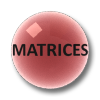
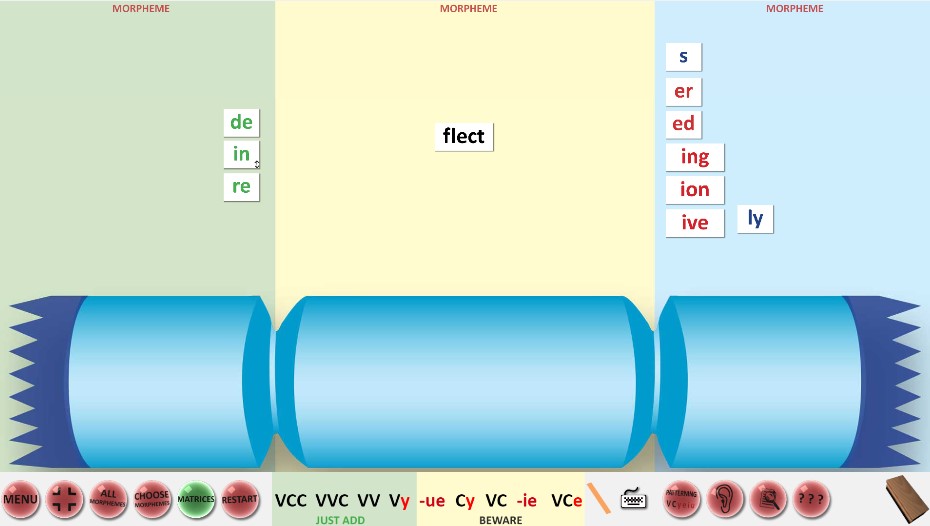
Meanings Mode
(Online Word Cracker)
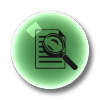

Morpheme
A morpheme is the smallest unit of meaning in a word. It can be a word in itself or a part of a word that cannot be further divided into smaller units of meaning.
For example, the word ‘smallest’ has two morphemes, it’s base ‘small’ (which we all know the meaning of) and the suffix ‘est’ (that means ‘most’ when compared with other small things).
The word morpheme also has two morphemes, the base ‘morph’ (which means a string of phonemes that can’t be broken down into smaller pieces that have meaning) and the suffix ‘eme’ (which means smallest unit of).
The word ‘dog’ contains one morpheme, but if we add another morpheme (the suffix ‘s‘) then it has two morphemes, with the ‘s‘ indicating more than one dog (plurality).
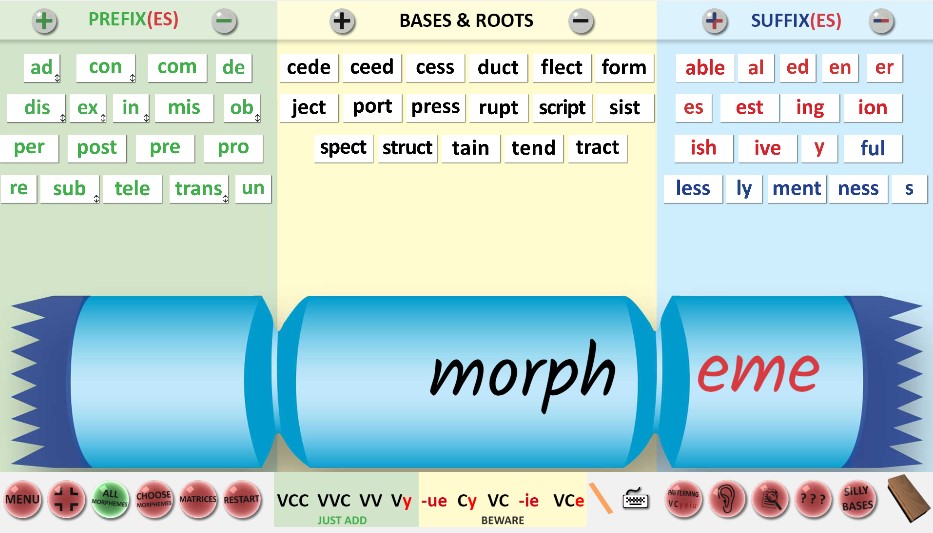
Morphology
The study of the structure of words and how they are formed.
Words can be divided into units of meaning. When these meaning parts (morphemes) are added or subtracted, a word’s a word’s overall meaning can change, as can its grammatical function. This area of word study is known as morphology.
Reading researchers have come to appreciate and emphasise the critical importance of teaching morphology to students with disorders of the printed word. However, all students benefit from explicit instruction in
morphology.
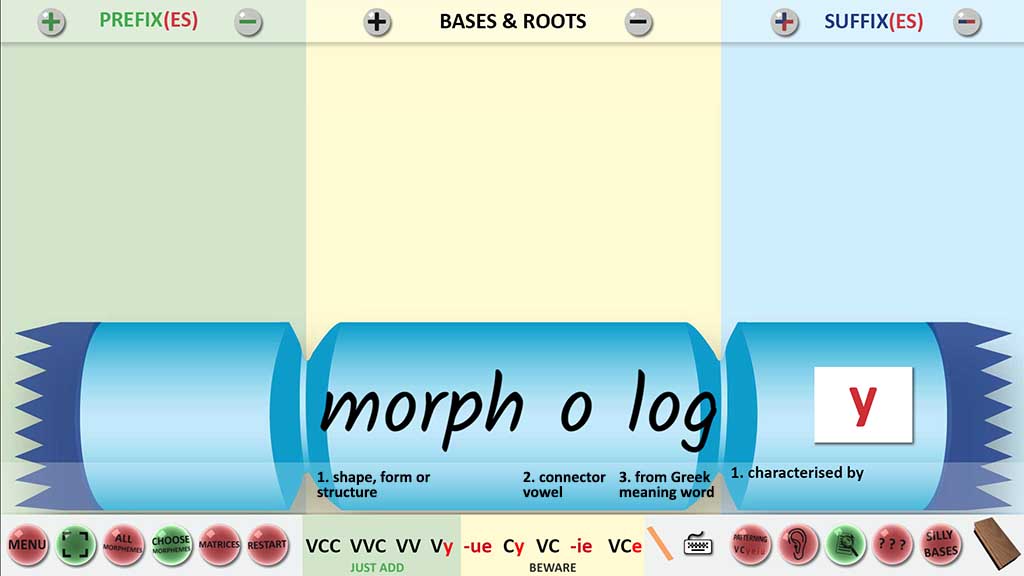
Morpheme Matrix
A matrix that illustrates the different prefixes and suffixes that can be added to a base or root to form words.

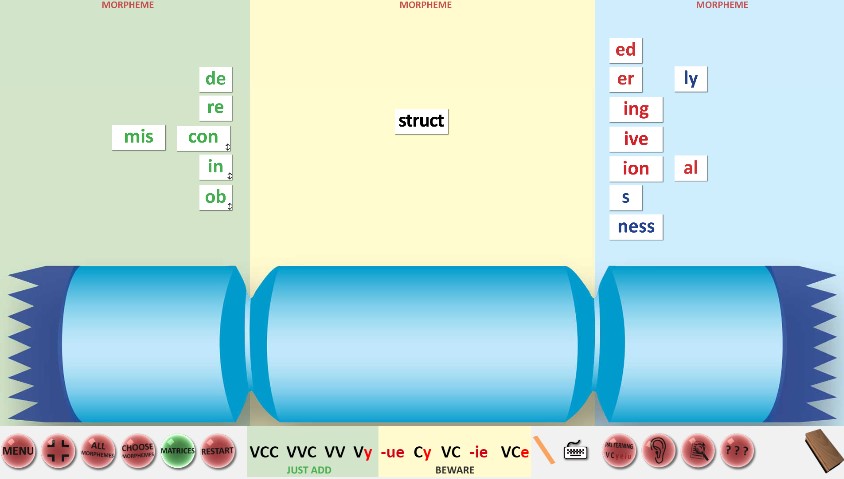
Morphological Awareness
A skill that helps students read and spell. Research has shown that morphological awareness ability is one of the skills that predicts how well students will perform on reading and spelling tasks (e.g., Bowers, Kirby, & Deacon, 2010; Goodwin & Ahn, 2013). It is a skill that helps student’s problem-solve words they do not know how to read and spell.”
Morphological Awareness: One Part of the Literacy Pie”, International Dyslexia Association (2017)

Prefix
An affix that is attached to the beginning of a word, such as “un-” in “unhappy”. The definition our students learn is
“A prefix is a letter or group of letters added to the start of a base word. It changes the meaning slightly”.

Suffix
An affix that is attached to the end of a word, such as “-able” in “believable”.
“A suffix is a letter or group of letters added to the end of a base word. It changes the meaning slightly”.
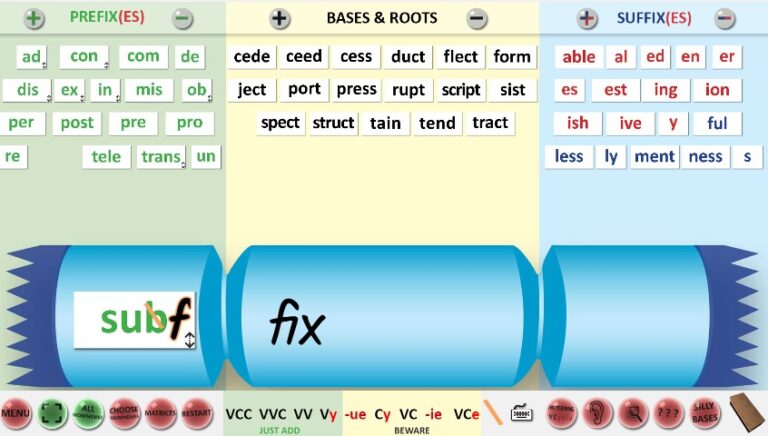
Morphology training
We have a comprehensive morphology training course if you want to learn more about morphology and how to teach it.

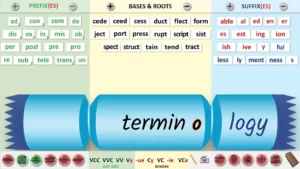


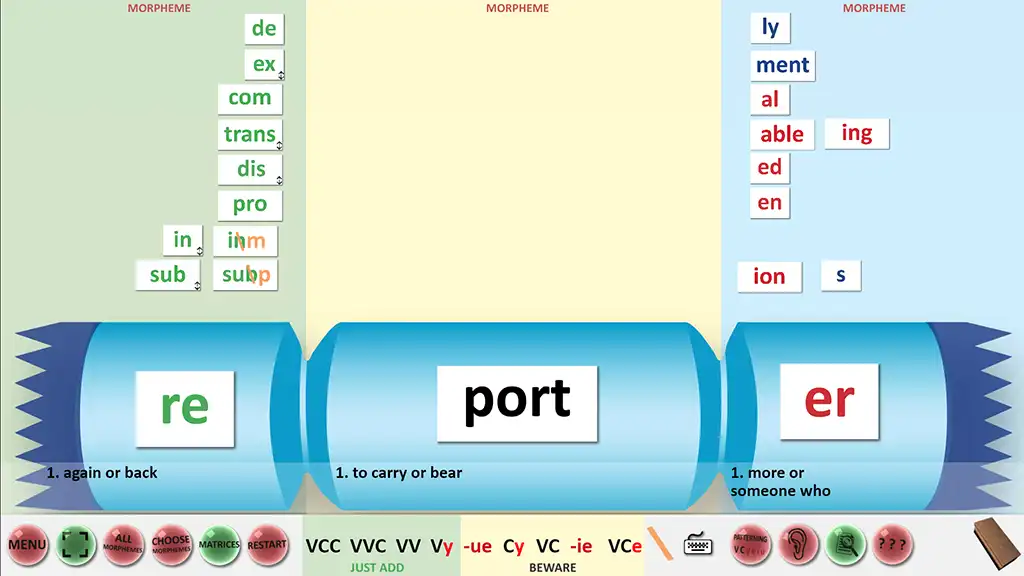
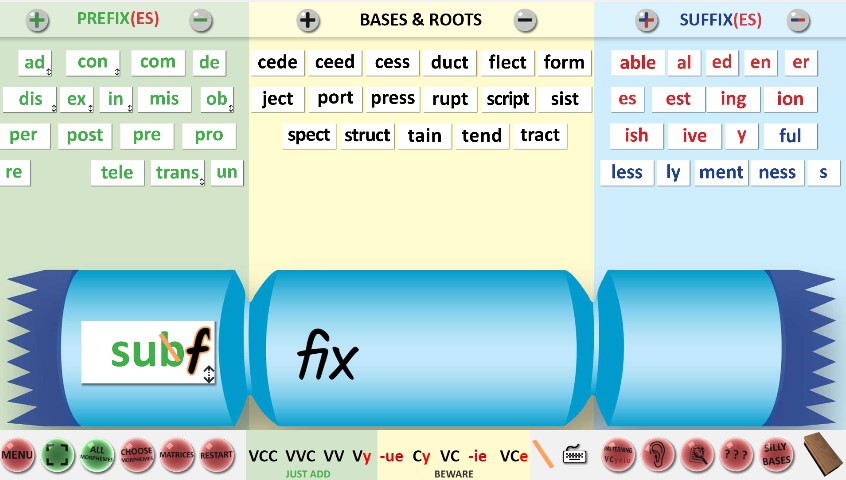
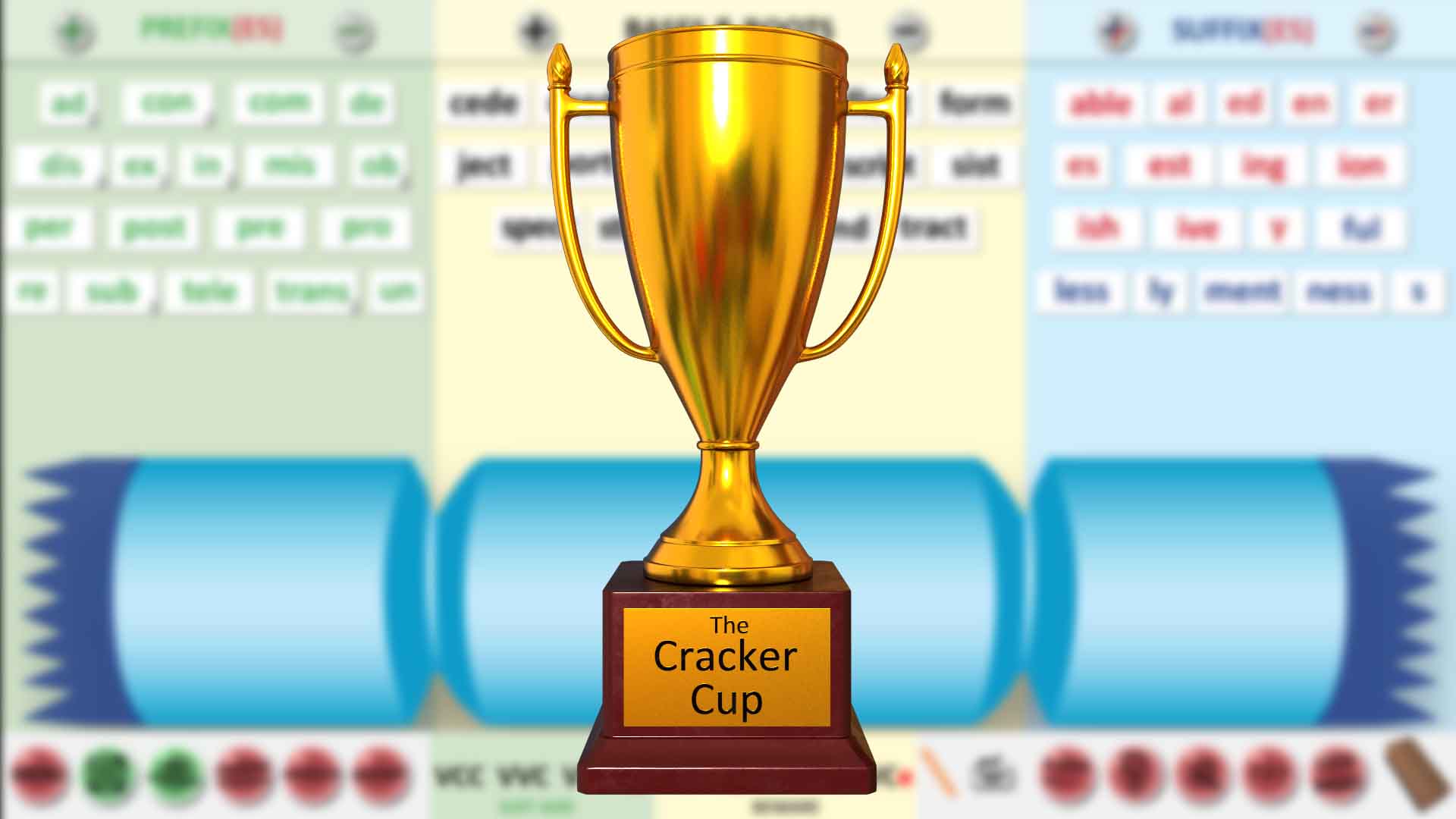

2 Responses
Hello,
I’m an educational consultant who works in MTSS literacy. The terminology section of your website is so valuable that I’ll be sharing with teachers in my upcoming vocabulary workshop! Well done. Thank you for making this resource free to all.
No problems Amy, I’m glad it was helpful!